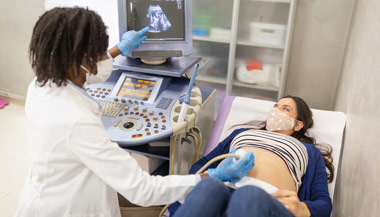Multiple Pregnancy
What You Need to Know
- Mothers carrying two or more fetuses need more calories, protein and other nutrients, including folic acid.
- You may need to see a maternal-fetal medicine specialist, also called a perinatologist, for special testing and ultrasound evaluations.
- The delivery method for your multiples will depend on many factors, including your health, and the health, positions and gestational age of your babies.
Management of Multiple Pregnancy
Your health care provider will help manage your multiple pregnancy based on your:
-
Pregnancy, overall health and medical history
-
Number of fetuses
-
Tolerance for specific medicines, procedures or therapies
-
Expectations for the course of the pregnancy
-
Personal preference
Your prenatal care plan may include:
-
Increased nutrition. Mothers carrying two or more fetuses need more calories, protein and other nutrients, including folic acid. On average, a woman’s caloric requirements will increase at least 40 percent for a multiple pregnancy. But your physician’s weight recommendation will be based on your weight at the beginning of pregnancy rather than on the number of babies you’re carrying.
-
More frequent prenatal visits. A multiple pregnancy increases the risk of complications. More frequent visits may help your doctor find complications early enough to implement effective treatment or management. Your nutritional status and weight should also be monitored more closely with a multiple pregnancy.
-
Physician referrals. You may need to see a maternal-fetal medicine specialist for special testing, ultrasound evaluations or coordinating the care of complications.
-
Increased rest. Some women may also need bed rest. This can take place either at home or in the hospital, depending on pregnancy complications and the number of fetuses. While preventive bed rest has not been shown to prevent preterm birth in multiple pregnancy, reduced activity may be recommended and beneficial.
-
Maternal and fetal testing. Testing may be needed to monitor the health of the fetuses, especially if there are pregnancy complications.
-
Tocolytic medicines. If you experience preterm labor, you may be given tocolytic drugs to help slow or stop your contractions. These may be given orally, by injection or intravenously. Tocolytic medicines often include nifedipine.
-
Corticosteroid medicines. Corticosteroid medicines may be given to help mature the lungs of the fetuses. Lung immaturity is a major problem for premature babies because it may cause breathing issues.
Delivery of a Multiple Pregnancy
The method of delivery will depend on many factors, including the mother’s health, fetal health, fetal position and gestational age.
Vaginal Delivery
Generally, if you are carrying twins, you should be able to deliver them vaginally if both fetuses are in the vertex (head facing down) position and there are no other complications. Also, in many cases where the first twin is vertex, but the second twin is not vertex (head not facing down), you can still have a vaginal delivery. After the first fetus delivers vaginally, the doctor will either turn the second fetus to the vertex position or deliver it breech (buttocks or feet are presented first). Since these procedures can increase the risk of problems, such as prolapsed cord (when the cord slips down through the cervical opening), an emergency Cesarean section (C-section) for the second fetus may be needed.
Vaginal deliveries often take place in an operating room because of the greater risk of complications during birth and the potential need for a C-section when delivering multiples.
C-Section
In the case of twins, if the first fetus is not vertex, both babies will likely be delivered by C-section. Most triplets and other higher-order multiples are also delivered by C-section.
Delivery by C-section is usually needed:
-
To deliver babies in abnormal positions
-
When the mother has certain medical conditions
-
If the babies are in fetal distress
-
If the pregnancy is monochorionic









